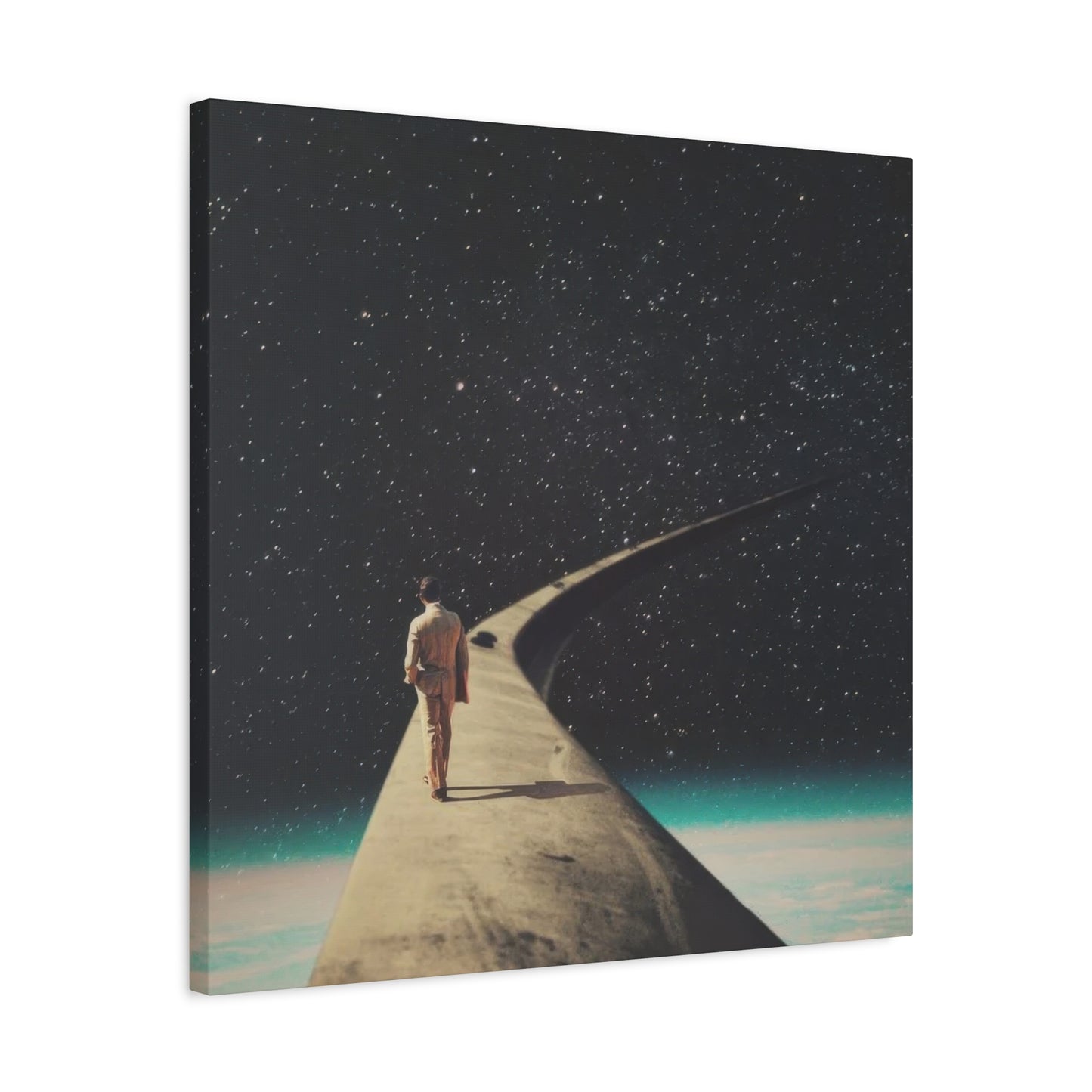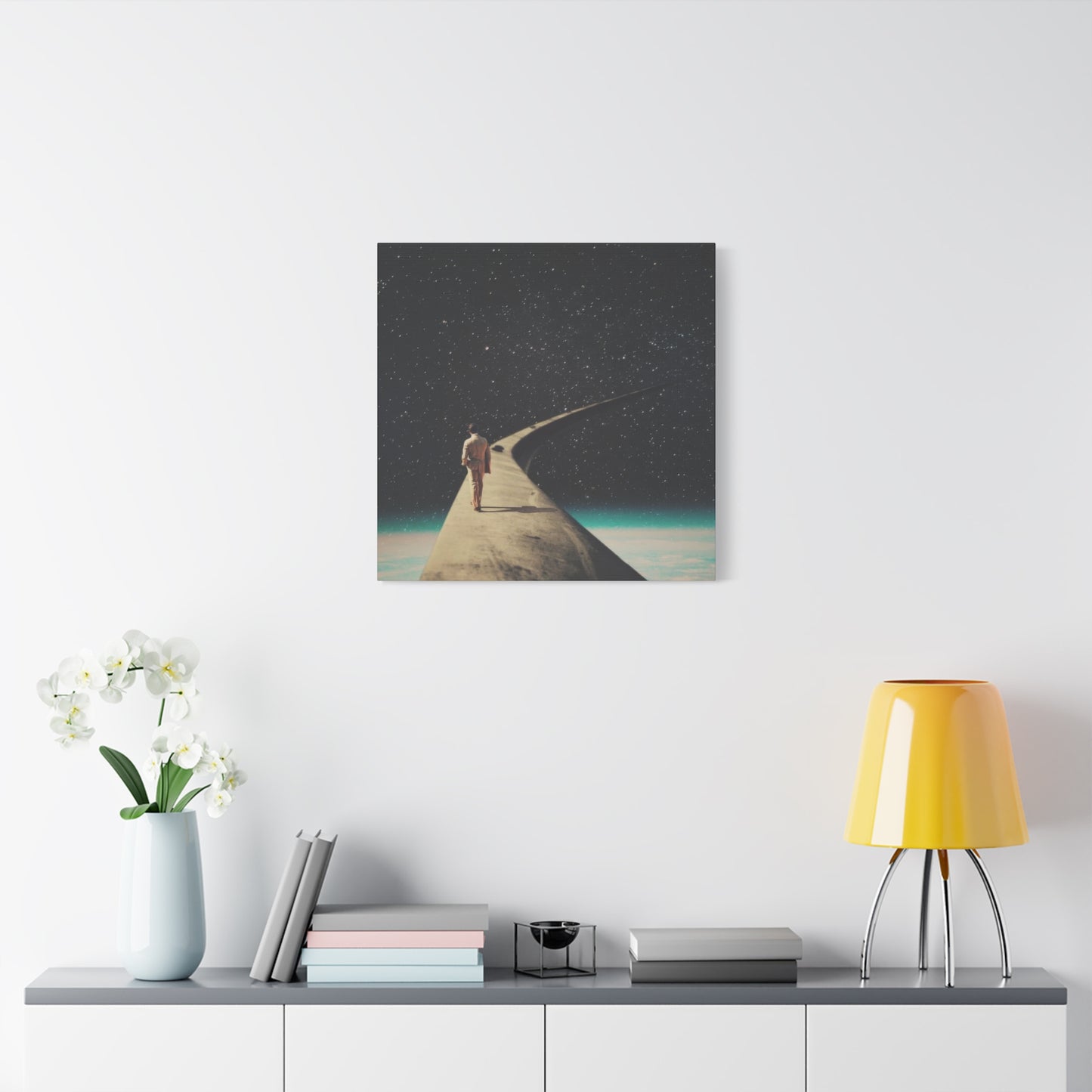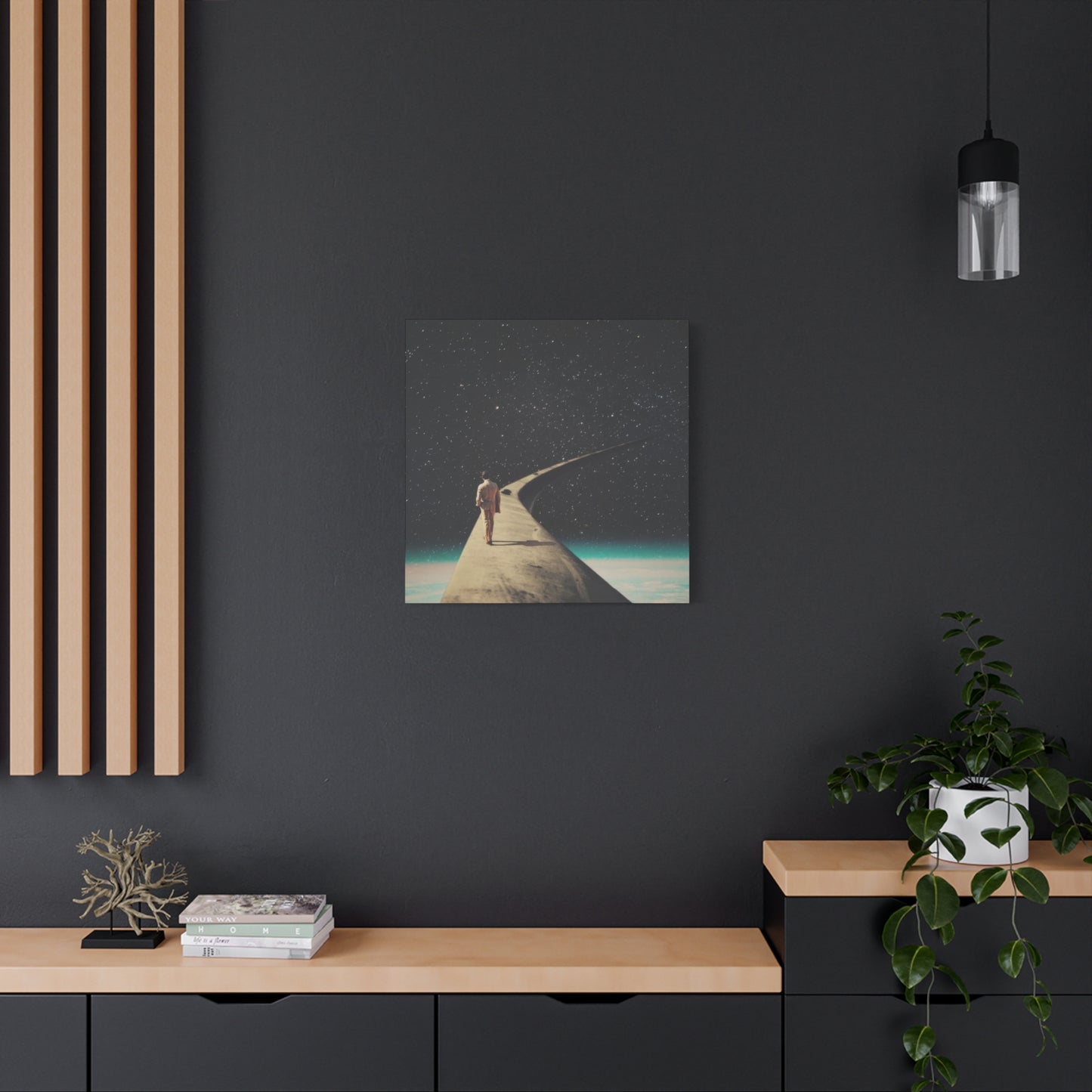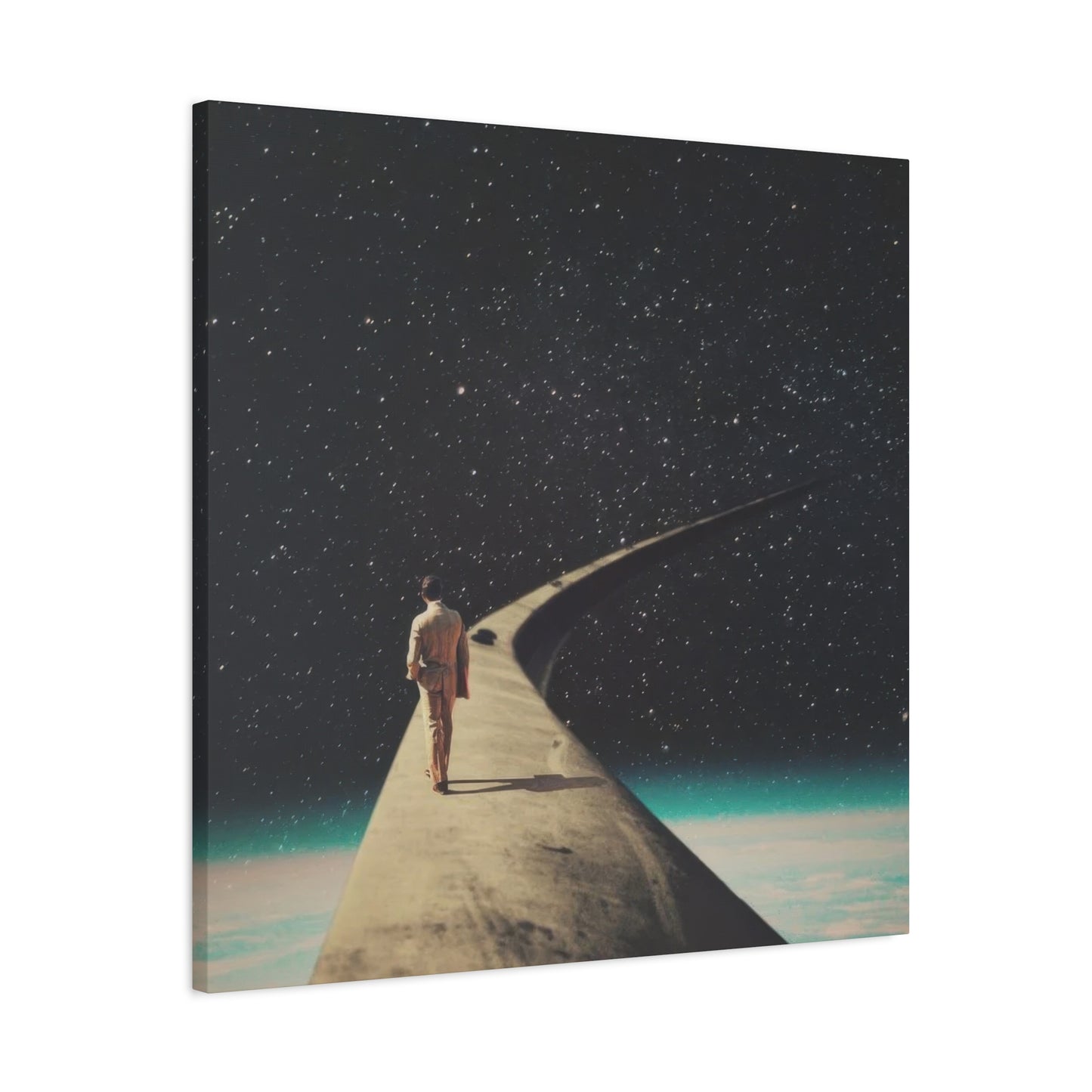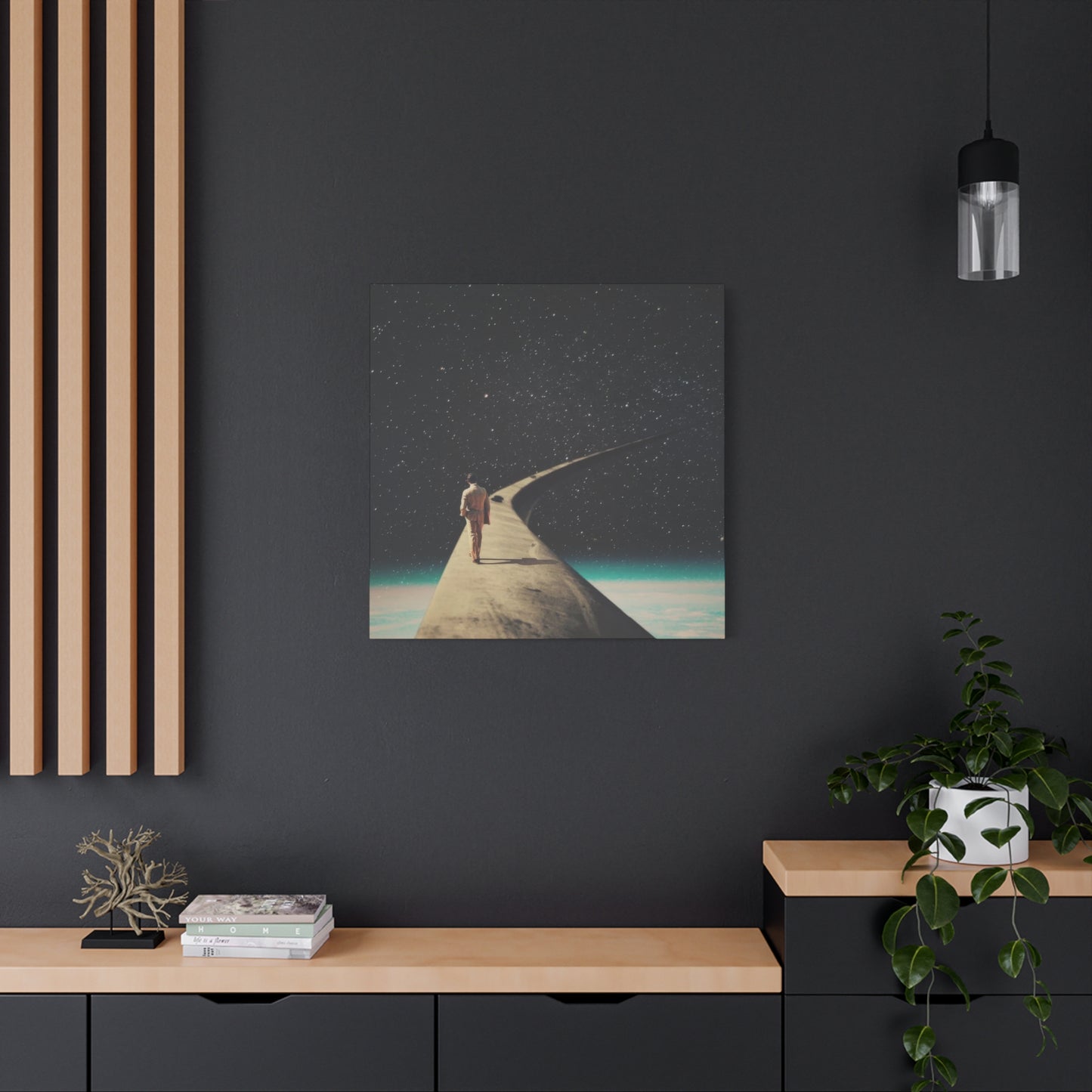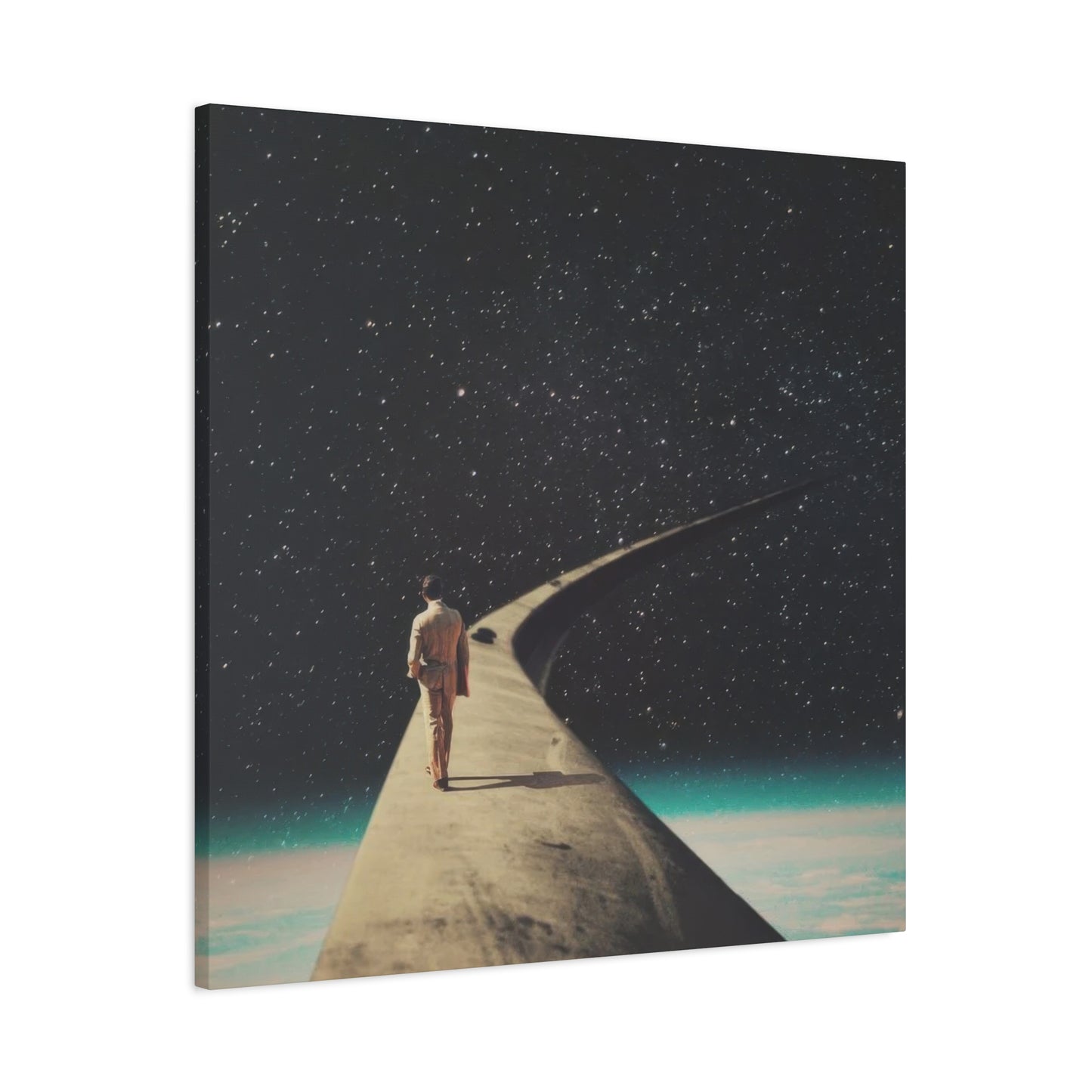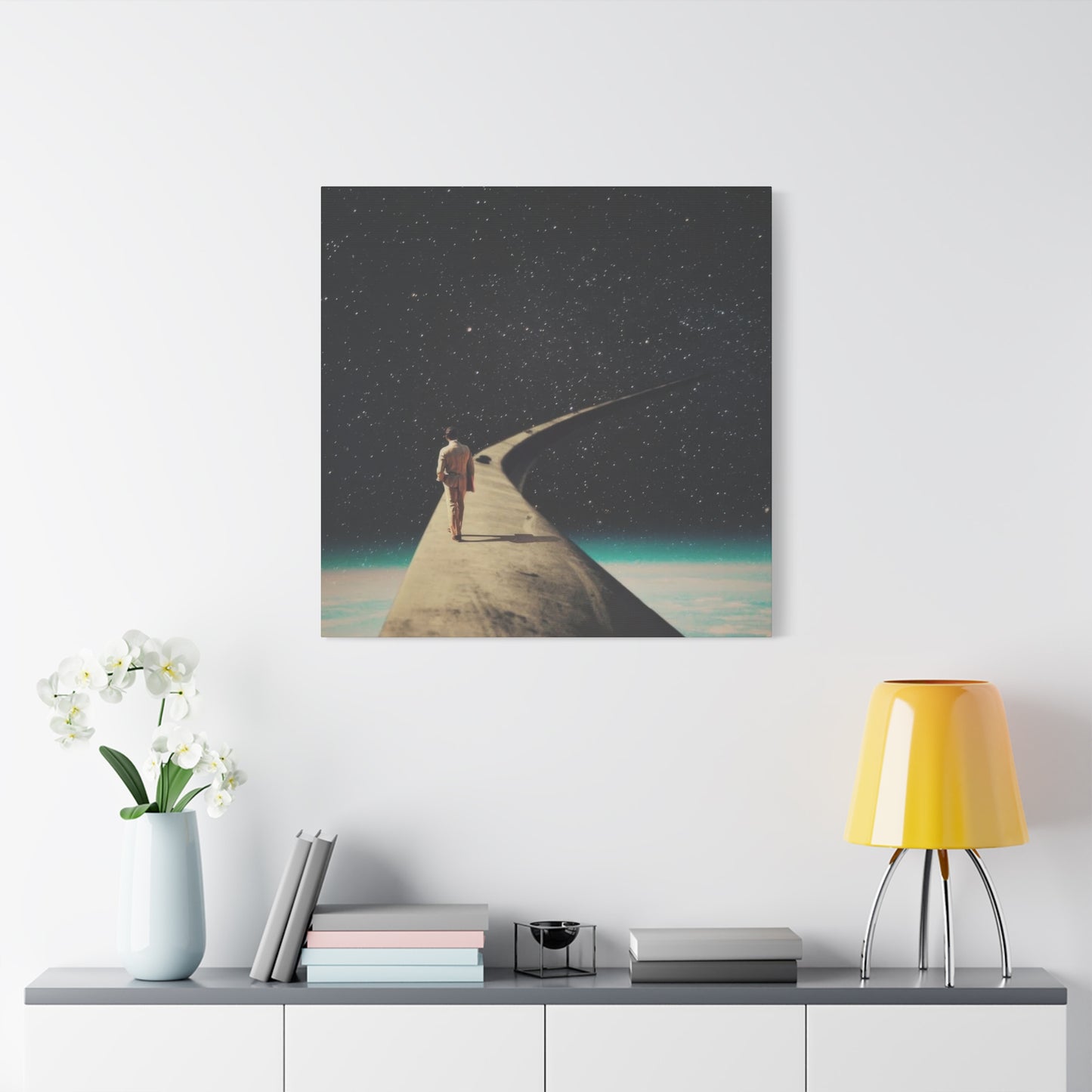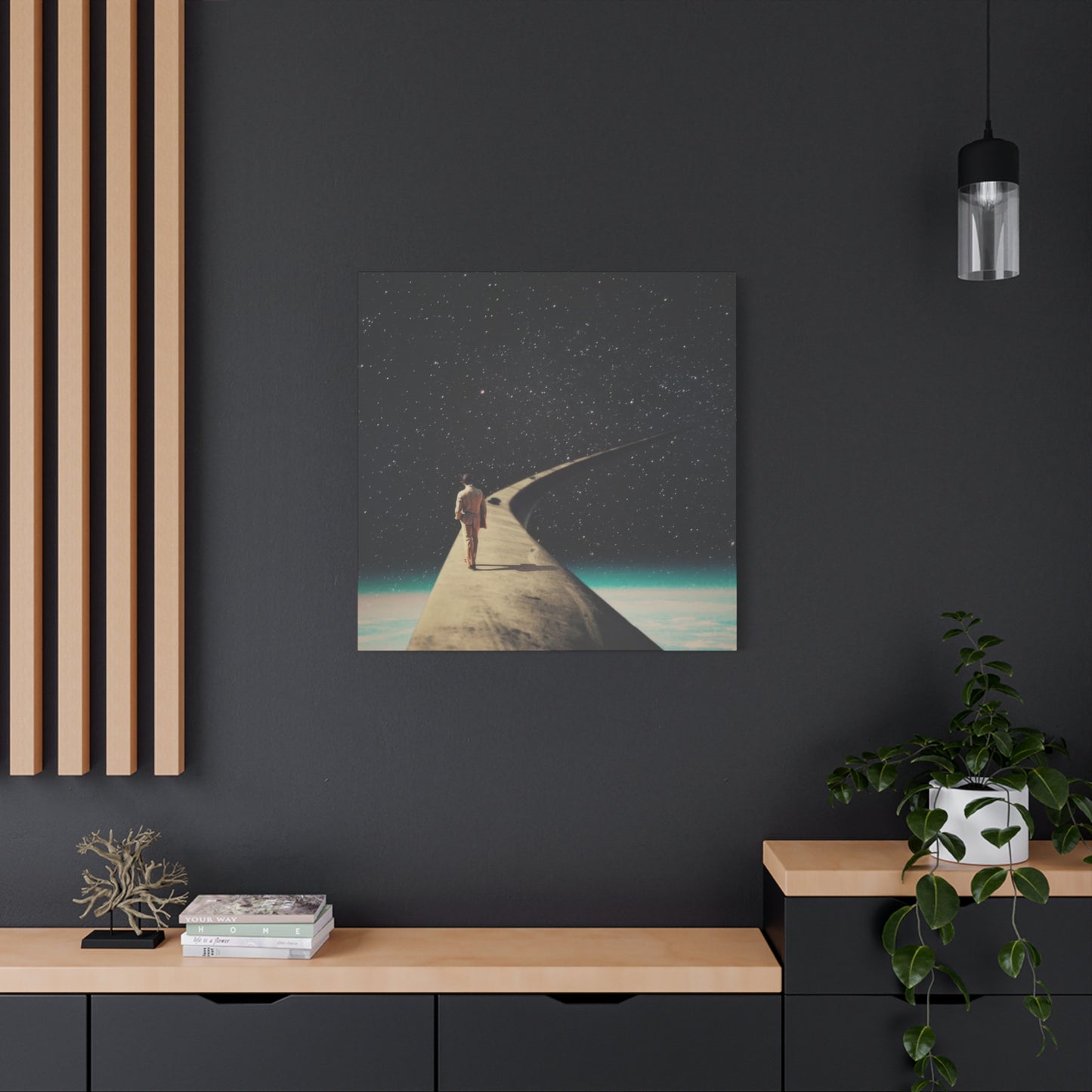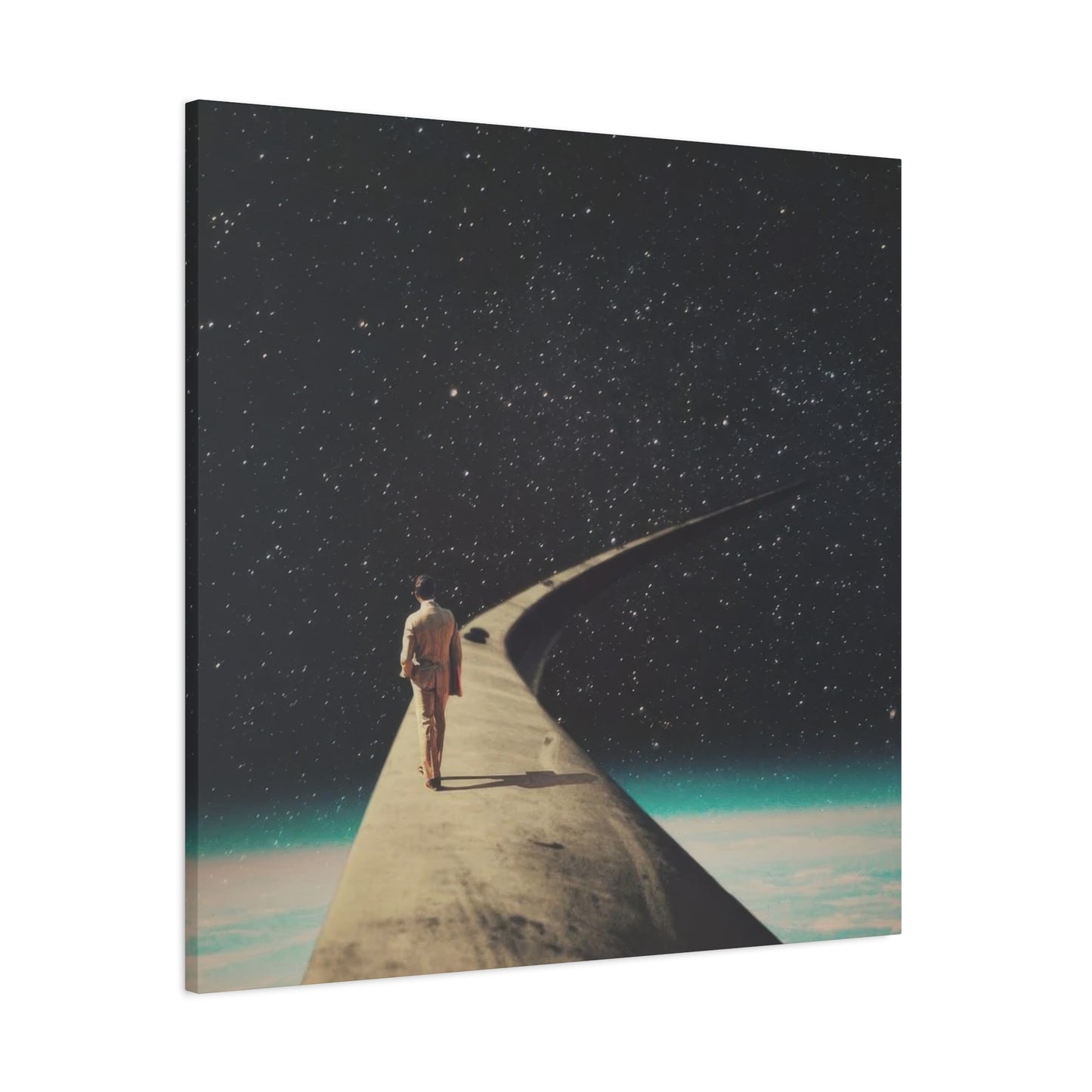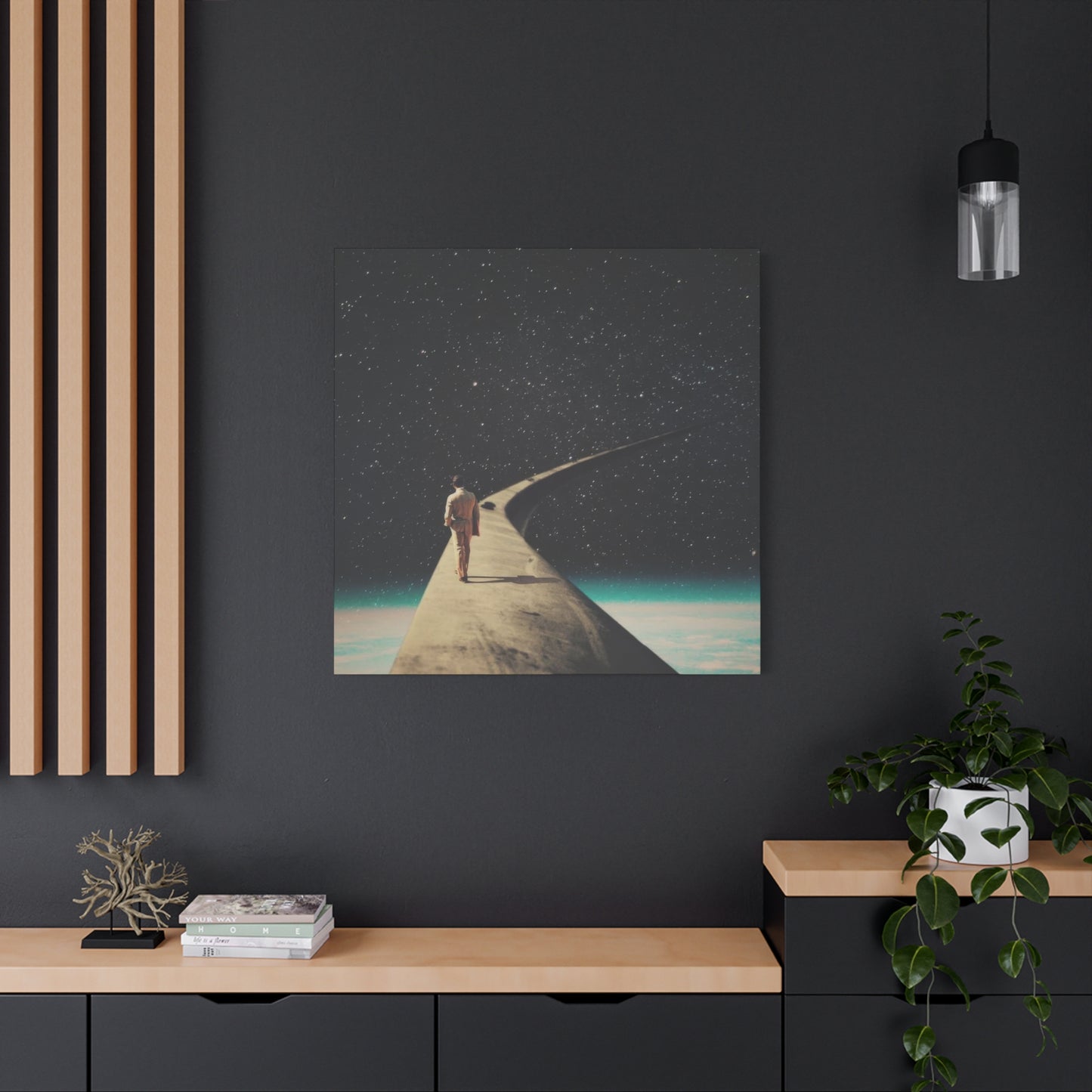Modern Storytelling on Canvas: Frank Moth’s We Chose This Road My Dear Wall Art
Frank Moth represents a revolutionary voice in contemporary digital art, creating mesmerizing visual narratives that blend vintage aesthetics with surrealist elements. The piece "We Chose This Road My Dear" stands as one of his most iconic works, capturing the imagination of art enthusiasts worldwide. This artwork exemplifies the artist's unique ability to merge nostalgic imagery with modern digital techniques, creating pieces that resonate deeply with viewers on both emotional and aesthetic levels.
Digital collage art has emerged as a powerful medium in recent years, allowing artists to manipulate and combine various visual elements to create entirely new narratives. Frank Moth has mastered this technique, developing a signature style that sets his work apart in the crowded contemporary art landscape. His creations often feature dreamlike scenarios where astronauts, vintage figures, and surreal landscapes coexist in harmonious yet unexpected ways.
The appeal of Frank Moth's wall art extends beyond mere decoration. Each piece tells a story, invites contemplation, and adds a layer of sophistication to any living space. "We Chose This Road My Dear" particularly embodies these qualities, making it a sought-after addition to modern homes, offices, and galleries. The artwork's composition, color palette, and thematic elements work together to create a visual experience that captivates viewers and sparks conversations.
Understanding the context and meaning behind this particular piece requires exploring the broader landscape of contemporary digital art, the artist's influences, and the cultural movements that have shaped modern visual expression. Frank Moth's work exists at the intersection of vintage nostalgia and futuristic imagination, creating a timeless quality that appeals to diverse audiences across generations.
The Artistic Vision Behind Frank Moth's Creative Process
Frank Moth's artistic journey began with a fascination for vintage imagery and the untapped potential of digital manipulation. His creative process involves carefully curating photographs, illustrations, and graphic elements from various time periods, then seamlessly blending them into cohesive compositions. This meticulous approach requires both technical skill and artistic intuition, as each element must contribute to the overall narrative while maintaining visual harmony.
The artist's vision extends beyond simple image combination. Frank Moth seeks to evoke specific emotions and thought processes through his work. "We Chose This Road My Dear" exemplifies this approach, using visual metaphors to explore themes of choice, journey, companionship, and the paths we take through life. The title itself suggests a shared decision, a mutual commitment to a particular direction, which adds layers of meaning to the visual elements present in the artwork.
Contemporary digital artists like Frank Moth have revolutionized how we perceive and consume art. Traditional boundaries between photography, illustration, and graphic design dissolve in his work, creating hybrid pieces that defy easy categorization. This genre-blending approach reflects our modern experience of visual culture, where images from different sources and eras constantly intermingle in our daily digital consumption.
The technical execution of Frank Moth's pieces demonstrates exceptional skill in color grading, composition, and digital manipulation. Every shadow, highlight, and color tone is carefully adjusted to create mood and atmosphere. The artist's ability to make disparate elements appear as if they naturally belong together speaks to his deep understanding of visual aesthetics and photographic principles.
Frank Moth's work also reflects broader cultural conversations about nostalgia, progress, and human connection. By placing vintage figures in surreal or futuristic contexts, he comments on our relationship with the past and our hopes for the future. "We Chose This Road My Dear" can be interpreted as a meditation on partnership, shared experiences, and the adventure of life itself.
Exploring the Visual Elements of We Chose This Road My Dear
The composition of "We Chose This Road My Dear" reveals Frank Moth's masterful understanding of visual storytelling. The artwork typically features carefully arranged elements that guide the viewer's eye through the piece, creating a narrative journey within the static image. Each component is deliberately placed to contribute to the overall atmosphere and meaning of the work.
Color plays a crucial role in establishing the mood of this piece. Frank Moth often employs vintage color palettes that evoke nostalgia and warmth, with muted tones and subtle gradations that feel both familiar and dreamlike. The color choices in "We Chose This Road My Dear" create an emotional resonance that connects viewers to memories and feelings they may not even consciously recognize.
The spatial relationships within the artwork deserve careful attention. Frank Moth manipulates scale and perspective to create surreal yet believable scenes. Figures may appear larger or smaller than logically possible, yet the overall composition maintains a sense of coherence. This skillful manipulation of reality is a hallmark of surrealist tradition, updated for the digital age.
Texture and detail add depth to Frank Moth's digital collages. Despite being digital creations, his works often incorporate the grain, imperfections, and character of analog photography. This intentional inclusion of vintage aesthetic qualities bridges the gap between old and new, creating artwork that feels both contemporary and timeless.
The symbolic elements within "We Chose This Road My Dear" invite multiple interpretations. Roads, journeys, and companionship serve as universal metaphors that resonate across cultures and experiences. Frank Moth's genius lies in presenting these themes through visual language rather than explicit messaging, allowing each viewer to bring their own understanding and emotional response to the work.
The Cultural Significance of Contemporary Digital Collage
Digital collage as an art form has gained significant recognition in recent decades, moving from experimental niche to mainstream acceptance. Artists like Frank Moth have been instrumental in elevating the medium, demonstrating that digital manipulation can produce work as meaningful and valuable as traditional artistic methods. This cultural shift reflects broader changes in how we create, consume, and value visual art.
The democratization of digital tools has enabled more artists to explore collage techniques, but few achieve the distinctive voice that characterizes Frank Moth's work. His success demonstrates that technical accessibility does not diminish the importance of artistic vision, creativity, and skill. "We Chose This Road My Dear" stands as evidence that digital art can achieve the same emotional depth and aesthetic power as any traditional medium.
Contemporary audiences have developed new ways of engaging with art, influenced by constant exposure to digital imagery. Frank Moth's work speaks directly to this modern sensibility while maintaining connections to art historical traditions. His pieces can be appreciated as standalone artworks or as part of broader conversations about surrealism, pop art, and postmodern aesthetics.
The popularity of Frank Moth's wall art reflects changing attitudes toward home decoration and personal expression. Modern consumers seek artwork that reflects their individual tastes and values rather than following prescriptive interior design rules. "We Chose This Road My Dear" appeals to those who appreciate thoughtful, conversation-starting pieces that add intellectual and emotional dimension to their living spaces.
Social media has played a significant role in Frank Moth's rise to prominence. Digital platforms allow artists to reach global audiences without traditional gatekeepers like galleries or critics. This direct connection between artist and audience has transformed the art world, enabling unique voices to find their community. Frank Moth's Instagram presence, for example, has introduced his work to millions who might never encounter it in physical gallery spaces.
Interior Design Applications for Frank Moth Wall Art
Incorporating "We Chose This Road My Dear" into interior spaces requires thoughtful consideration of size, placement, and surrounding design elements. Frank Moth's artwork possesses sufficient visual interest to serve as a focal point, making it ideal for prominent wall spaces where it can command attention and set the tone for entire rooms.
Living rooms benefit tremendously from the addition of meaningful wall art. "We Chose This Road My Dear" works particularly well above sofas or mantels, where it can anchor seating arrangements and provide a conversation starting point for guests. The artwork's contemplative quality makes it suitable for spaces designed for relaxation and social interaction.
Bedroom environments also prove ideal for Frank Moth's creations. The dreamlike, introspective nature of pieces like "We Chose This Road My Dear" complements the restful atmosphere of sleeping quarters. Positioned above beds or on feature walls, the artwork can inspire reflection before sleep and upon waking, adding meaningful dimension to personal spaces.
Office and workspace applications shouldn't be overlooked. Frank Moth's art brings creative energy and visual interest to professional environments without being distracting or inappropriate. "We Chose This Road My Dear" in a home office or studio can serve as inspiration, reminding viewers of shared journeys and collaborative efforts.
The color palette of Frank Moth's work typically coordinates well with various interior design styles. Whether your aesthetic leans toward mid-century modern, contemporary minimalism, or eclectic bohemian, "We Chose This Road My Dear" can integrate seamlessly. The vintage-inspired tones work particularly well with neutral backgrounds, allowing the artwork to shine without competing with busy patterns or bold colors.
Scale considerations are crucial when selecting Frank Moth wall art. Larger prints make bold statements in spacious rooms with high ceilings, while smaller versions suit more intimate spaces or gallery wall arrangements. The composition of "We Chose This Road My Dear" typically maintains its impact across various sizes, though specific details may be more appreciable in larger formats.
Technical Aspects of Digital Collage Creation
Understanding the technical process behind Frank Moth's creations enhances appreciation for the skill involved. Digital collage requires proficiency in image editing software, typically Adobe Photoshop or similar professional tools. Artists must understand layers, masks, blending modes, and adjustment layers to seamlessly combine disparate photographic elements.
Source material selection represents a critical first step in creating works like "We Chose This Road My Dear." Frank Moth curates vintage photographs, often from mid-century archives, selecting images with particular aesthetic qualities and thematic relevance. This curation process requires extensive research and a trained eye for visual potential.
Color grading and tonal adjustments unify the various elements within a digital collage. Frank Moth employs sophisticated color correction techniques to ensure that elements from different original sources appear to exist within the same lighting environment. This technical skill separates professional-level work from amateur attempts at digital manipulation.
Composition in digital art follows many principles established by centuries of painting and photography. Frank Moth demonstrates mastery of concepts like the rule of thirds, leading lines, and focal point creation. "We Chose This Road My Dear" likely employs these classical compositional techniques adapted for digital media.
Resolution and file management become crucial considerations for artwork intended for print production. Frank Moth's pieces must maintain quality across various sizes, requiring work at high resolutions with careful attention to detail that will remain sharp when enlarged. This technical requirement adds complexity to the creative process.
The finishing touches on digital collages often include texture overlays, grain effects, and subtle imperfections that lend authenticity to the vintage aesthetic. Frank Moth skillfully adds these elements to create artwork that feels discovered rather than manufactured, despite being entirely digital in origin.
The Philosophy and Meaning Behind the Title
"We Chose This Road My Dear" as a title immediately establishes themes of partnership, decision-making, and journey. The use of "we" implies shared experience and mutual commitment, while "chose" emphasizes agency and intentionality. Together with "this road," the phrase evokes life's journey metaphor, suggesting that the subjects of the artwork are partners in navigation of life's path.
The addition of "my dear" introduces intimacy and affection to the statement. This term of endearment transforms what might be a simple declaration into something more tender and personal. Frank Moth's choice of this particular phrasing suggests the artwork explores romantic or deeply bonded relationships.
Philosophical interpretations of the title can extend to existential questions about choice and fate. The emphasis on choosing suggests free will and responsibility for one's direction in life. This aligns with existentialist thought that emphasizes human agency and the significance of our decisions in creating meaning.
The road as metaphor has deep roots in literature, poetry, and popular culture. From Robert Frost's "The Road Not Taken" to countless songs about highways and journeys, the road represents life's passage through time. Frank Moth taps into this rich symbolic tradition while adding visual and contemporary dimensions.
Collective versus individual experience forms another layer of meaning. "We chose" rather than "I chose" emphasizes shared responsibility and communal experience. This subtle shift in perspective suggests that the most meaningful journeys are those undertaken with companions, that our choices gain significance through their impact on relationships.
The declarative nature of the statement also matters. "We chose" rather than "we might choose" or "we should choose" indicates a decision already made, a commitment already honored. This finality gives the artwork a sense of resolution and acceptance, perhaps suggesting peace with past decisions regardless of their outcomes.
Vintage Aesthetic in Modern Context
Frank Moth's deliberate use of vintage imagery creates a complex relationship between past and present. By selecting mid-century photographs and styling, he taps into cultural nostalgia while creating something entirely contemporary. This temporal blending characterizes much modern visual culture, where retro aesthetics coexist with cutting-edge technology.
The appeal of vintage aesthetics in contemporary art relates to psychological and cultural factors. Nostalgia provides comfort in uncertain times, offering connections to periods perceived as simpler or more authentic. Frank Moth exploits this emotional response while acknowledging that his vintage-styled works are thoroughly modern constructions.
Color palettes from mid-century photography possess particular warmth and character that digital photography often lacks. Frank Moth replicates these tonal qualities intentionally, creating artwork that feels emotionally resonant rather than clinically perfect. The slight fading, warm tones, and soft contrasts of vintage photography contribute to the dreamlike quality of pieces like "We Chose This Road My Dear."
Fashion and cultural elements from past decades add layers of visual interest to Frank Moth's compositions. Vintage clothing, hairstyles, and accessories carry associations and meanings that enrich the artwork's narrative potential. These elements help establish the timeless quality that prevents the work from feeling dated despite its retro inspiration.
The grain and imperfections of analog photography serve as intentional aesthetic choices in digital work. Frank Moth adds these elements to create authenticity and character, acknowledging that technical perfection can sometimes feel cold or sterile. These carefully controlled imperfections humanize the digital creation process.
Analog photography's limitations actually enhanced artistic creativity, forcing photographers to work within constraints that often produced happy accidents and unique results. Frank Moth's work honors this tradition while enjoying the freedom of digital manipulation, creating a best-of-both-worlds approach that appeals to modern sensibilities.
Surrealism and Its Influence on Contemporary Visual Art
Frank Moth's work clearly draws from surrealist traditions established by artists like Salvador Dali, Rene Magritte, and Max Ernst. Surrealism sought to unlock the creative potential of the unconscious mind, creating dreamlike scenarios that defied logical explanation. Contemporary digital artists inherit this tradition, using new tools to explore similar territories.
The juxtaposition of unexpected elements forms a core surrealist technique that Frank Moth employs masterfully. "We Chose This Road My Dear" likely combines elements that wouldn't naturally coexist, creating visual surprises that engage viewers and prompt them to construct their own narratives. This technique keeps artwork interesting through repeated viewings.
Dream logic rather than rational causality governs surrealist compositions. Frank Moth creates scenes that feel emotionally true even when physically impossible. This emotional authenticity transcends literal representation, allowing artwork to communicate feelings and ideas that resist straightforward depiction.
Scale manipulation, a favorite surrealist device, appears frequently in Frank Moth's portfolio. Objects and figures of impossible sizes coexist peacefully in his compositions, creating visual interest and symbolic meaning. These scale shifts can represent psychological states, power dynamics, or simply serve aesthetic purposes.
The unconscious mind as creative source remains relevant in contemporary art. While Frank Moth works with conscious intention and digital precision, his pieces tap into universal symbols and archetypes that resonate with viewers' unconscious associations. This depth of connection explains why his artwork generates strong emotional responses.
Surrealism's influence extends beyond visual arts into literature, film, and popular culture. Frank Moth's work participates in this broader cultural conversation, demonstrating how surrealist principles remain vital and relevant decades after the movement's founding. His digital techniques provide new methods for exploring these enduring artistic concerns.
Print Quality and Material Considerations
Reproducing digital artwork like "We Chose This Road My Dear" for wall display involves important technical considerations. Print quality dramatically affects how viewers experience the art, making material and process selection crucial for collectors and decorators seeking to display Frank Moth's work.
Giclée printing represents the gold standard for fine art reproduction. This method uses high-quality inkjet printers with archival inks to produce prints that rival original artwork in color accuracy and detail. Giclée prints of Frank Moth's work maintain the subtle color gradations and fine details essential to his aesthetic.
Paper selection influences both appearance and longevity of prints. Museum-quality art papers provide excellent color reproduction and archival stability, ensuring that "We Chose This Road My Dear" maintains its visual impact for decades. Different paper textures can subtly alter the artwork's character, with smooth papers emphasizing precision while textured papers add organic quality.
Canvas prints offer alternative presentation options for Frank Moth wall art. Stretched canvas creates a gallery-like appearance without requiring framing, while canvas texture adds physical dimension to digital imagery. However, canvas may not capture fine details as precisely as paper prints.
Acrylic and metal print options provide contemporary presentation methods for modern interiors. Face-mounted acrylic creates depth and luminosity, making colors appear more vibrant and adding a luxurious quality. Metal prints offer industrial aesthetic appeal with excellent durability and unique visual characteristics.
Size considerations affect both visual impact and technical quality. While Frank Moth's artwork maintains integrity across various dimensions, extremely large prints require source files of sufficient resolution. Understanding the relationship between viewing distance, print size, and detail perception helps in selecting appropriate dimensions for specific spaces.
Framing choices significantly impact how "We Chose This Road My Dear" integrates into interior spaces. Simple, clean frames allow the artwork to speak for itself, while ornate frames can add traditional elegance. Mat boards provide breathing room around the image and protect it from contact with frame glass.
The Role of Nostalgia in Contemporary Visual Culture
Nostalgia functions as a powerful emotional driver in contemporary culture, influencing everything from entertainment to design. Frank Moth's work taps into this nostalgia, particularly for the mid-20th century, a period associated with optimism, adventure, and aesthetic distinctiveness. Understanding nostalgia's role enhances appreciation of his artistic choices.
The psychology of nostalgia reveals that it serves important emotional functions. Research indicates that nostalgic feelings increase social connectedness, enhance mood, and provide meaning during times of uncertainty. Frank Moth's vintage-inspired imagery triggers these beneficial psychological responses, contributing to his work's emotional impact.
Generational differences in nostalgic response add complexity to reception of Frank Moth's art. Older viewers might experience direct memory activation, recalling their own experiences from the depicted era. Younger audiences engage with idealized versions of periods they never experienced, creating synthetic nostalgia based on media representations rather than personal memory.
The aesthetics of mid-century design possess particular appeal in contemporary contexts. The clean lines, optimistic color palettes, and sense of possibility associated with that era contrast sharply with today's complex, often anxious cultural moment. Frank Moth channels this aesthetic to create spaces of visual calm and contemplation.
Nostalgia in art risks becoming mere escapism if not balanced with contemporary relevance. Frank Moth avoids this pitfall by creating work that acknowledges the past while remaining firmly grounded in present-day artistic conversations. His pieces function as bridges between eras rather than simple reproductions of vintage styles.
The commercialization of nostalgia raises questions about authenticity and manipulation. While some cultural critics view nostalgic appeal with suspicion, viewing it as cynical marketing, Frank Moth's work demonstrates that nostalgia can serve genuine artistic purposes. His thoughtful engagement with vintage aesthetics transcends simple retro trend-following.
Symbolism and Metaphor in Frank Moth's Artistic Language
Symbolic communication forms the foundation of Frank Moth's artistic practice. Rather than depicting scenes literally, he constructs visual metaphors that convey complex ideas and emotions. "We Chose This Road My Dear" likely employs multiple symbolic elements that work together to create layered meanings.
The road itself carries ancient symbolic weight, representing life's journey from birth to death and all the choices made along the way. In Frank Moth's hands, this universal symbol gains new dimensions through visual treatment and contextual placement. The specific characteristics of the depicted road contribute to interpretation of the artwork's meaning.
Figures within the composition serve as symbolic stand-ins for viewers themselves. By featuring vintage subjects whose faces may be obscured or genericized, Frank Moth creates space for viewers to project themselves into the narrative. This psychological engagement transforms passive viewing into active participation.
Astronomical and celestial elements frequently appear in Frank Moth's portfolio, serving as symbols of dreams, aspirations, and the vast unknown. If "We Chose This Road My Dear" includes such elements, they likely represent the magnitude of life's journey and the mysteries that lie ahead for the artwork's subjects.
Temporal symbols within the work create dialogue between past, present, and future. Vintage figures might encounter futuristic or impossible scenarios, suggesting that time itself is fluid in the realm of dreams and memory. This temporal play enriches the artwork's philosophical dimensions.
Scale and proportion function symbolically in Frank Moth's compositions. Enormous figures might represent psychological weight or importance, while tiny elements could indicate vulnerability or insignificance. These visual choices communicate relationships and ideas without requiring textual explanation.
Light and shadow carry emotional and symbolic meanings in visual art. Frank Moth's treatment of illumination creates mood while potentially symbolizing knowledge versus ignorance, hope versus despair, or consciousness versus unconsciousness. Careful observation of lighting choices reveals additional layers of artistic intention.
Building a Collection Around Frank Moth's Artistic Style
Collectors drawn to "We Chose This Road My Dear" often wish to acquire multiple pieces that complement each other. Building a cohesive collection requires understanding the themes, aesthetics, and principles that characterize Frank Moth's broader body of work.
Thematic coherence provides one approach to collection building. Frank Moth explores recurring themes of journey, exploration, relationship, and dreamlike scenarios. Selecting multiple works that develop these themes creates intellectual and emotional depth within a collection.
Color palette consistency helps maintain visual harmony when displaying multiple pieces together. Frank Moth's characteristic muted tones, vintage color grading, and warm hues work well in combination. Collecting pieces that share similar color approaches ensures they complement rather than compete with each other.
Varied but related compositions prevent visual monotony while maintaining stylistic coherence. Mixing pieces with different subject matter and compositional approaches keeps collections interesting without losing the unifying thread of Frank Moth's distinctive aesthetic.
Size variation adds dynamic interest to gallery walls and collection displays. Combining a large statement piece like "We Chose This Road My Dear" with smaller complementary works creates visual hierarchy and guides viewer attention through the collection.
Exploring work from different periods in Frank Moth's career can reveal artistic development while maintaining overall stylistic consistency. Earlier and later pieces might show evolution in technique or thematic focus, adding historical dimension to collections.
Balancing accessibility with investment potential matters for serious collectors. While affordability democratizes art appreciation, limited editions and original works may appreciate in value over time. Understanding the art market helps collectors make informed decisions aligned with their goals and resources.
The Digital Art Market and Accessibility
The rise of digital art has transformed market dynamics, making works by artists like Frank Moth more accessible to broader audiences. Print-on-demand services, online marketplaces, and direct artist sales have disrupted traditional gallery models, creating new opportunities and challenges.
Democratization of art collecting represents a significant cultural shift. Previously, original artwork or high-quality prints remained financially out of reach for many enthusiasts. Digital reproduction technologies allow more people to enjoy "We Chose This Road My Dear" in their homes at various price points and quality levels.
Limited editions maintain value and exclusivity within accessible markets. Frank Moth and similar artists often release numbered, signed prints that command higher prices while limiting availability. This approach balances democratization with traditional collecting dynamics.
The debate over digital versus physical ownership continues to evolve. While physical prints of "We Chose This Road My Dear" can be displayed and enjoyed tangibly, digital files offer different advantages in terms of storage, reproduction, and sharing. Non-fungible tokens have recently entered this conversation, though their long-term significance remains uncertain.
Online platforms enable direct artist-collector relationships that bypass traditional intermediaries. Frank Moth can sell directly to fans through personal websites and social media, retaining more control and profit while offering collectors authenticity and connection to the artist.
Global reach transforms local artists into international phenomena. Frank Moth's audience extends worldwide, with fans in countries that might never host physical exhibitions of his work. This geographic democratization fundamentally changes how artistic reputation and success develop.
Quality control challenges emerge in accessible markets. Unauthorized reproductions and lower-quality prints can dilute artistic vision and mislead consumers. Collectors seeking authentic "We Chose This Road My Dear" prints must verify sources and understand quality indicators.
Historical Context of Collage as Artistic Medium
Collage emerged as a recognized artistic technique in the early 20th century, though practices of combining disparate visual elements date back much further. Understanding this history provides context for appreciating Frank Moth's contemporary innovations in the medium.
Pablo Picasso and Georges Braque pioneered Cubist collage, incorporating newspaper clippings, wallpaper, and other materials into painted compositions. These experiments challenged assumptions about artistic materials and representation, establishing collage as a legitimate fine art technique.
Dada artists embraced collage for its ability to create unexpected juxtapositions and challenge conventional meaning. Hannah Höch, Raoul Hausmann, and others created politically charged works that used collage to critique society and culture. This subversive potential continues to influence contemporary artists including Frank Moth.
Surrealists adopted collage techniques to explore unconscious mind and create dreamlike scenarios. Max Ernst's collage novels particularly prefigured Frank Moth's narrative approach, combining vintage imagery to create mysterious, evocative stories. This surrealist tradition clearly influences "We Chose This Road My Dear."
Pop Art of the 1960s employed collage and appropriation to comment on consumer culture and mass media. Artists like Richard Hamilton and Robert Rauschenberg blurred boundaries between high and low culture, a democratizing impulse that resonates with contemporary digital art practices.
Analog collage required physical cutting, arranging, and adhering of materials, a labor-intensive process that limited experimentation. Digital tools liberated artists from these constraints, enabling the seamless compositions characteristic of Frank Moth's work. However, the conceptual foundations remain rooted in historical practice.
The transition from analog to digital collage parallels broader shifts in creative production across media. Just as photography once disrupted painting, and film challenged theater, digital techniques have transformed visual art. Frank Moth stands within this continuum of technological evolution in artistic practice.
Color Theory and Emotional Impact in Visual Design
Frank Moth's sophisticated use of color contributes significantly to the emotional impact of "We Chose This Road My Dear." Understanding color theory principles reveals how he creates mood, atmosphere, and psychological resonance through carefully controlled palettes.
Warm versus cool color balances establish emotional temperature in artwork. Frank Moth often employs warm tones like amber, sepia, and soft pinks that create feelings of nostalgia, comfort, and intimacy. These warm palettes make viewers feel welcomed into the artwork's narrative space.
Color saturation affects perception of age and authenticity. The muted, slightly faded quality characteristic of Frank Moth's palette mimics vintage photography's natural aging, triggering associations with memory and history. This subtle desaturation prevents colors from feeling aggressive or demanding.
Complementary color relationships create visual interest and harmony simultaneously. When Frank Moth includes blue skies against warm-toned figures, the complementary relationship adds vibrancy while maintaining overall cohesion. These strategic color choices guide attention and create focal points.
Monochromatic or limited palette approaches unify compositions effectively. By restricting color range, Frank Moth ensures that no element visually competes for dominance unless intentionally emphasized. This restraint characterizes sophisticated color usage in "We Chose This Road My Dear."
Color psychology influences emotional response in measurable ways. Warm colors generally evoke positive, nostalgic, or energetic feelings, while cool colors suggest calm, distance, or melancholy. Frank Moth's characteristic warmth contributes to the generally optimistic, reflective quality of his work.
Cultural color associations add additional layers of meaning. While some color responses appear universal, others vary across cultures. Frank Moth's international audience brings diverse color associations to interpretation of his work, enriching its possible meanings.
Framing and Presentation Options for Maximum Impact
How "We Chose This Road My Dear" is framed and presented significantly affects its aesthetic impact and integration into living spaces. Understanding available options helps collectors make choices that honor the artwork while complementing their interiors.
Traditional framing with mat boards creates classic presentation suitable for various settings. Black, white, or natural wood frames offer versatile options that work with most decor styles. Mat boards provide visual breathing room and prevent the artwork from touching frame glass, offering both aesthetic and preservation benefits.
Frameless mounting creates contemporary, minimalist presentation. Direct mounting to backing board or floating mounts give "We Chose This Road My Dear" a modern gallery aesthetic. This approach works particularly well in contemporary or industrial-styled interiors.
Shadow box framing adds dimensional interest and premium presentation quality. The gap between artwork and frame glass creates subtle shadow effects that emphasize the piece as a three-dimensional object rather than flat image. This technique particularly suits collectors who view artwork as investment pieces.
Canvas gallery wraps eliminate framing requirements entirely. When printed on canvas and stretched over wooden frames, "We Chose This Road My Dear" gains sculptural presence with image extending around edges. This presentation method suits casual, contemporary spaces.
Acrylic face mounting creates stunning depth and color vibrancy. The artwork is mounted to backing then covered with clear acrylic, making colors appear to glow. This premium presentation option commands attention and suits modern, design-forward environments.
Museum glass offers superior protection and clarity for framed pieces. Anti-reflective properties allow viewing from various angles without glare, while UV protection prevents fading. Though more expensive than standard glass, museum glass preserves artwork quality over time.
Professional versus DIY framing involves trade-offs between cost and quality. While custom framing requires significant investment, it ensures proper treatment of artwork with appropriate materials and techniques. Budget-conscious collectors might frame smaller pieces themselves while investing in professional framing for signature pieces like "We Chose This Road My Dear."
The Intersection of Photography and Digital Manipulation
Frank Moth's work exists at the fascinating intersection of photography and digital art, raising questions about medium specificity and artistic authenticity. Understanding this relationship enhances appreciation of his technical achievements and conceptual innovations.
Source photography provides the raw material for Frank Moth's compositions. Whether from personal archives, stock photography, or public domain collections, these photographs carry their own histories and meanings. The artist's selection process identifies images with latent potential for transformation and recombination.
The photographic index, photography's relationship to reality, complicates digital manipulation ethics. Traditional photography claims documentary authority based on mechanical reproduction of reality. Frank Moth's transformations acknowledge this photographic truth while explicitly embracing artistic fiction.
Transparency versus opacity in artistic process remains contentious in digital art. Some argue that digital manipulations should be disclosed to maintain honesty with audiences. Frank Moth's stylization makes his process obvious, embracing artifice rather than attempting photorealistic deception.
The skill required for convincing digital compositing rivals traditional artistic techniques. Creating "We Chose This Road My Dear" demands understanding of light, shadow, perspective, and color that equals knowledge required for painting or traditional photography. Technical ease of digital tools doesn't diminish the expertise needed for excellent results.
Historical precedents for photographic manipulation extend back to the medium's origins. Victorian photographers routinely combined multiple negatives, retouched prints, and staged elaborate scenes. Frank Moth continues this tradition of photographic construction rather than simple documentation.
The distinction between photography and illustration blurs in digital practice. Frank Moth's work functions simultaneously as both, or perhaps as neither, existing in a hybrid category that contemporary art increasingly occupies. This categorical ambiguity reflects broader postmodern questioning of medium boundaries.
Social Media and the Democratization of Art Distribution
Social media platforms have fundamentally transformed how artists like Frank Moth build audiences, distribute work, and sustain creative practices. Instagram, in particular, has become a crucial tool for visual artists, enabling direct connection with global audiences.
Visual-first platform design makes Instagram ideal for showcasing artwork. The grid layout allows Frank Moth to present his portfolio cohesively while individual posts highlight specific pieces like "We Chose This Road My Dear." Hashtags and discovery algorithms expose work to interested viewers who might never encounter it otherwise.
Direct artist-audience relationships bypass traditional gatekeepers. Rather than requiring gallery representation or critical approval, Frank Moth can build reputation through consistent quality and audience engagement. This democratization has discovered and elevated numerous talents who might have languished in obscurity under previous systems.
Community building through social media creates support networks and collaborative opportunities. Artists connect with peers, share techniques, and cross-promote work. Frank Moth benefits from a community of digital artists who collectively elevate the medium's status and visibility.
Commercial opportunities emerge directly from social media presence. Followers become customers through links to print shops, commission opportunities, and licensing deals. "We Chose This Road My Dear" likely generates income through multiple channels enabled by the artist's online presence.
Algorithm dependence creates vulnerability for social media-reliant artists. Platform changes can dramatically affect visibility and reach. Frank Moth must navigate these algorithmic systems while maintaining artistic integrity and authentic audience connections.
The expectation of free content challenges monetization efforts. While social media exposure benefits artists, it also creates audiences accustomed to consuming artwork without payment. Balancing accessible sharing with sustainable income generation remains an ongoing challenge.
Psychological Impact of Art in Living Spaces
The artwork we choose for our environments profoundly affects our psychological state and daily experience. "We Chose This Road My Dear" by Frank Moth offers specific psychological benefits that make it valuable beyond mere decoration.
Visual complexity without chaos characterizes psychologically beneficial art. Frank Moth's work provides sufficient detail and interest to engage attention without overwhelming viewers. This balance creates restful contemplation rather than visual stress.
Meaningful content adds psychological depth to aesthetic pleasure. "We Chose This Road My Dear" invites reflection on relationships, choices, and life journey. This contemplative dimension provides ongoing value, as viewers discover new meanings through repeated exposure.
Nostalgia's psychological benefits include increased social connectedness and enhanced mood. By triggering nostalgic responses, Frank Moth's vintage aesthetic contributes to emotional wellbeing. Even viewers without personal memories of the depicted era can experience beneficial nostalgic feelings.
Art as conversation starter facilitates social connection. When guests notice and comment on "We Chose This Road My Dear," opportunities emerge for discussing taste, meaning, and shared experiences. These conversations strengthen relationships and create memorable interactions.
Personal identity expression through environmental choices contributes to psychological authenticity. Displaying Frank Moth's work signals intellectual curiosity, aesthetic sophistication, and appreciation for thoughtful creativity. This self-expression reinforces personal identity and creates living spaces that genuinely reflect who we are.
The presence of beauty in everyday environments improves quality of life measurably. While subjective, beauty triggers genuine physiological responses including stress reduction and mood enhancement. Surrounding ourselves with artwork we find beautiful, like "We Chose This Road My Dear," contributes to overall wellbeing.
Conclusion
Modern Storytelling on Canvas: Frank Moth’s We Chose This Road My Dear Wall Art exemplifies the power of contemporary figurative painting to convey emotion, narrative, and human experience within interior spaces. Frank Moth’s work merges raw emotional expression with subtle, nuanced details, resulting in canvases that communicate stories of connection, journey, and shared experience. This particular piece, with its evocative title and imagery, invites viewers to reflect on life’s choices, companionship, and the roads we travel, making it not only a decorative statement but a meaningful focal point that enriches both the aesthetic and emotional atmosphere of a room.
The appeal of Moth’s artwork lies in its ability to blend personal narrative with universal resonance. While the composition may appear intimate and minimalist at first glance, the nuanced gestures, expressions, and spatial dynamics invite the viewer into a broader exploration of human emotion and relational themes. The piece’s title, We Chose This Road My Dear, reinforces the storytelling aspect, prompting reflection on shared decisions, perseverance, and the emotional undertones of life’s journey. By placing such artwork in a home or gallery, viewers are offered a space to connect with the narrative, encouraging both contemplation and conversation.
From an interior design perspective, Moth’s figurative wall art is highly versatile. Its modern, subtle palette and thoughtful composition allow it to complement contemporary, minimalist, or even eclectic interiors. A single canvas can dominate a living room or study as a dramatic statement piece, while smaller or paired works can be arranged in a gallery format to create layered storytelling across a wall. The careful placement of the artwork ensures it interacts harmoniously with surrounding furniture, lighting, and textures, amplifying its visual impact and narrative presence.
Color, contrast, and composition are central to the piece’s effectiveness. Moth employs a muted yet evocative palette that emphasizes emotion over spectacle. Subtle tonal variations, the interplay of light and shadow, and the careful rendering of human form create depth, focus, and intimacy. These elements not only enhance the realism of the subjects but also invite the viewer to project their own experiences, fostering a personal and immersive connection with the work. Such artistry demonstrates that modern figurative pieces can be simultaneously aesthetic, narrative, and emotionally resonant.
Beyond its visual and design impact, the artwork carries symbolic significance. It reflects themes of companionship, choice, and shared experience, emphasizing the human condition and the emotional landscapes we navigate daily. Integrating such art into living spaces allows homeowners to infuse their interiors with layers of meaning, elevating the environment beyond decoration to one of contemplation, empathy, and narrative depth. This fusion of aesthetics and introspection makes Moth’s canvases compelling anchors for both private and public spaces, where art becomes a medium for dialogue and reflection.
Technically, Moth’s work demonstrates mastery in composition, spatial awareness, and expressive detail. The human figures, though often stylized and simplified, convey emotional depth through posture, gesture, and context. The careful balance between negative space and figure placement ensures that the viewer’s attention is drawn purposefully while allowing room for interpretation and personal engagement. This deliberate execution ensures that the canvas retains its impact across diverse viewing environments.
Moreover, We Chose This Road My Dear encourages thoughtful interior styling. Complementary décor—subdued furnishings, textured fabrics, and ambient lighting—can enhance the contemplative mood, highlighting the artwork’s subtle nuances while reinforcing the overall aesthetic of the room. The result is a space where design and narrative merge seamlessly, creating an environment that is both visually harmonious and emotionally engaging.
Ultimately, Frank Moth’s figurative wall art demonstrates that modern storytelling on canvas can transform interiors into spaces of reflection, connection, and aesthetic sophistication. By integrating works like We Chose This Road My Dear thoughtfully, homeowners and curators elevate both the look and the emotional resonance of their spaces.
In essence, Modern Storytelling on Canvas: Frank Moth’s We Chose This Road My Dear Wall Art underscores the potential of contemporary figurative painting to combine visual beauty with narrative depth. Through expressive composition, subtle tonality, and thematic resonance, this artwork transforms walls into portals of emotion, reflection, and personal engagement, leaving a lasting impression of modern sophistication, human connection, and timeless storytelling.





















